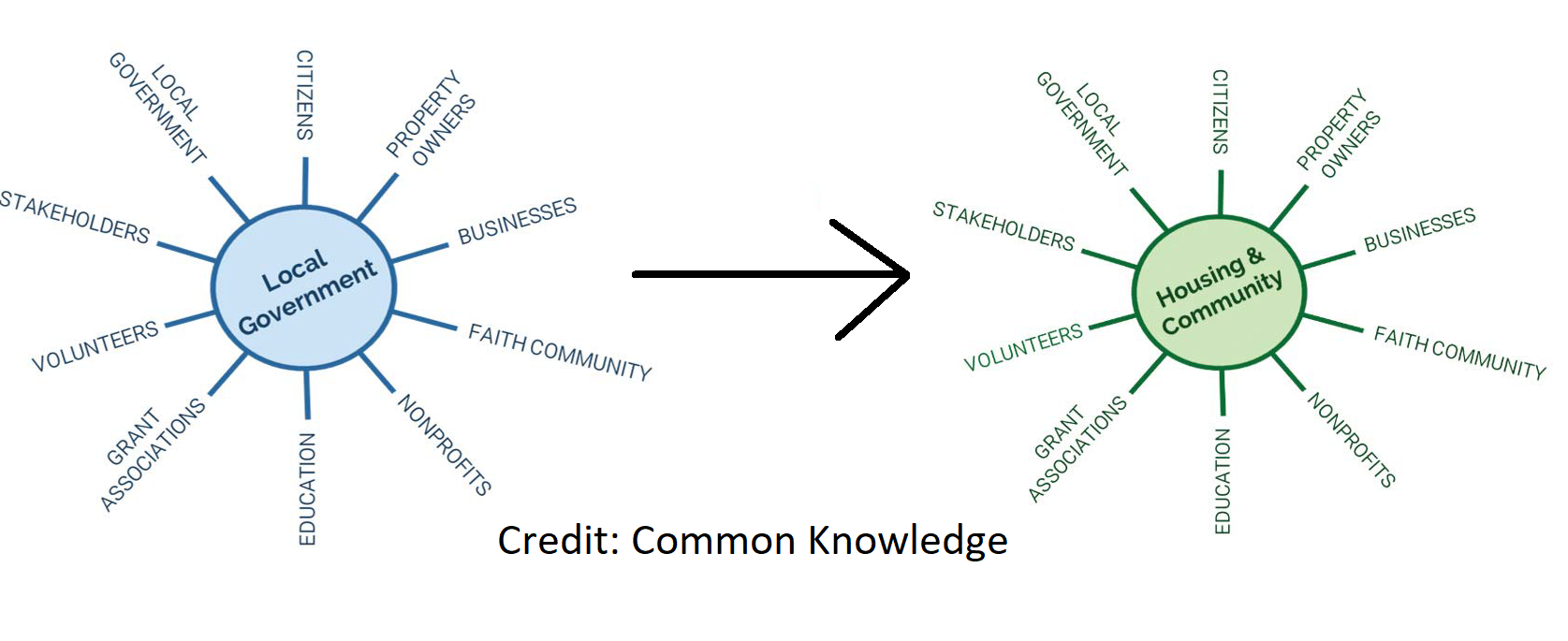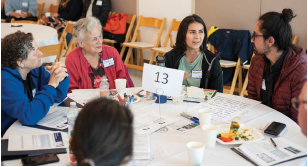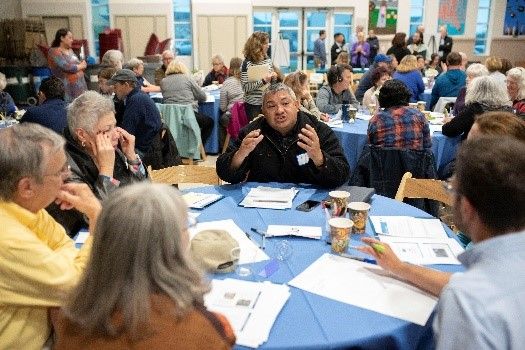COMMUNITY ENGAGEMENT PROGRAM
The Community Engagement Program is an initiative of Home for All designed to experiment with the most up-to-date forms of community engagement in select communities within San Mateo County.
Overview
The Community Engagement Program is an initiative of Home for All that uses inclusive and innovative community engagement strategies in communities within San Mateo County.
With the goal of engaging a wider audience of community members in creating a vision towards their a livable community, this Program has been designed as a collaborative learning exchange. This framework can help inform community engagement efforts in other cities and towns in San Mateo County and beyond.
Community Engagement Resources
The Community Engagement Resource Manual consists of various phases to encourage broader participation in housing conversations in cities and towns. An overview of each phase with resources is discussed in depth in the following sections.
Phase 1: Outreach and Listening in the Community
Local governments are often seen as the primary entity responsible for “solving” housing challenges. Reframing this thinking to center the issue and identify local government as one of many actors that can help address the issue, leads to constructive engagement and collaborative solutions.


Making progress on housing requires new approaches – new participants and perspectives – to create a positive and more inclusive environment for housing decisions. Using interactive outreach that is attentive to the community’s starting points will help you engage a broader range of perspectives, listen for prevailing narratives in your community, and understand how the community is experiencing shortage of housing.
When considering a community engagement process, cities benefit by starting from a place of inquiry. What has been learned from past conversations about housing? Where is there confusion? What information do we need to gather?
To ensure successes, reflect openly and honestly on current community conditions as well as your organization’s support for taking on a new project.
Prior to any community engagement effort, kick-off the effort by convening key city representatives to agree on goals and establish next steps. The following are documents that can help teams with project planning in the initial stages.
Planning Resources
Councilmembers and Planning Commissioners play an important role as listeners before, during and after the community conversations. Through this process, they are better informed about how housing issues are affecting the community and the solutions with greatest community interest.
A best practice is to start the community engagement process with a presentation to your City Council and provide updates throughout the process.
Community partners are essential in helping a city connect with underrepresented populations and those who have not participated in traditional civic processes.
Some partners that have helped cities find out how their community is experiencing housing challenges include: Libraries, cultural associations, schools, faith and service organizations, non-profits, local businesses, neighborhood associations, and many more.
A good first step is doing a candid assessment of which relationships are strong and which might need special attention through a variety of outreach methods. The following resources will help identify and expand your network of community partners.
Outreach Resources
Communication Resources
Pop-up outreach is a great way to hear from people who may not be able attend community meetings by going out into the community setting. These temporary “pop-up” locations are staffed by friendly “field ambassadors” who serve as listeners and provide relevant information about the upcoming community conversation.
Some places that participating cities have used for popups are transit stations, libraries, school pickups, cultural markets, farmers markets, coffee shops, etc.
Use the listening guide below to start conversations with community members and invite them to upcoming events. Listen for and keep track of key themes from the community to include in the community conversations and reporting. This will ensure that even those who were not able to attend community conversations are part of the process.
Phase 2: Community Conversations

Community conversations promote dialogue among community members with varying perspectives while decision makers listen to the diverse experiences of their constituents. Offering community members, elected officials and city staff this participatory and learning-oriented conversation is central to successful engagement.
The primary focus of the first meeting is to elicit key community values and principles that will inform the entire community engagement process. By interacting with peers, community members can identify shared values and explore what really matters to them in more detail than they could in, for example, a public comment period at a city council meeting.
This is the typical sequence of a Community Conversation model that cities in San Mateo County have used and resources that are essential for planning and executing learning-oriented community meetings:

Meeting Planning Resources
- CLEAR Conversation Handout
- Community Conversation Planning Worksheet
- Project Planning Worksheet
- CLEAR Conversation Task Tracker
Meeting Materials
Framing can be defined as choosing what to say, how to say it, and what to leave unsaid. When we frame our conversations about housing around shared values and solutions, it lays the foundation for a productive and learning-oriented discussion. The ways we talk about housing and invite participation are key aspects to consider when launching any engagement effort. Home for All has partnered with the Frameworks Institute to understand how to talk about housing in the context of shared values that will yield positive and productive results.
- You Don’t Have to Live Here
- Piecing It Together Playbook
- Check out the Frameworks Institute’s website for resources on framing messages about housing.
During a follow-up meeting, it is important to confirm the community values identified through earlier engagement and invite input from new participants. The second meeting can be more flexible and it can provide an opportunity to get specific feedback on the policy options highlighted in the first meeting. More discussion or adding a gallery walk on specific housing options are a few ways that cities have chosen to approach subsequent meetings.
The resource below will help you approach planning and designing subsequent meetings about specific housing options a community can consider after you’ve heard more broadly from your community.
Phase 3: Sustaining Two-Way Engagement

Following the primary engagement phase, how do you make sure that the time and energy invested in developing a larger audience of more informed and engaged community continues to pay dividends? A City’s housing solutions will be supported by a series of conversations over the next several years. Keeping in contact with the community is essential to sustaining momentum.
Following the primary engagement phase of the community conversations, keep in contact with community members, partners, and your City Council to utilize positive momentum for other planning or housing decisions.
Follow up on opportunities and new ideas that community members share. As an example, some cities have responded to the information needs that they heard from their community and created Housing Resource Guides in multiple languages.
The following resources will assist in thanking attendees and developing a meeting report that is shared widely with those you engaged. This is an opportunity for people who were engaged to share the meeting report and what they learned with others in their networks.
Meeting Reporting & Next Step Resources
- Reporting on Community Conversations
- Sample Meeting Report: Brisbane
- Bilingual Thank You Email: Half Moon Bay
- Sample Housing Guide: San Mateo

Use existing city channels and partner networks to provide regular housing updates; potential channels are newsletters, blog posts, social media, and pop ups. Whether in person or online, offer regular occasions for community members to share their feelings and experiences so that you can keep current on community perspectives and information needs.
- Sample Website: Portola Valley
- Sample Website: Pacifica
- Sample Website: Brisbane
- Sample Newsletter: Brisbane
- Sample Blog Posts: Redwood City
Consider ways to connect engagement on housing to other existing city efforts such as sustainability, social services, transportation, and city planning. Think about locations and occasions where you can continue to reach community members. Hold a pop-up during farmers markets, community festivals or holiday celebrations.
Maintaining credibility with partners after a series of community conversations requires following up on the policy conclusions. Cities that have partnered with Home for All have found diverse ways to pursue community-supported solutions to housing challenges.
For example, Portola Valley rewrote their City’s rules for Accessory Dwelling Units after many residents provided input during their community conversation. In fact, several residents opened up their own homes to for a tour of second units.
Cities that have used this community engagement model for housing issues have extended the model to other topics like sea level rise, community relations, and commercial development to name a few. Many of the efforts invested finding community super-connectors and community groups engaged in housing issues can pay off in exploring other topics.